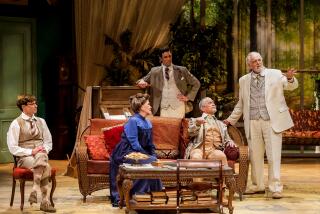Review: ‘Viceroy’s House’ opens the door to a key era in India’s past
- Share via
“Viceroy’s House,” which largely succeeds in its attempt to present a comprehensive, yet efficient look at the 1947 partitioning of the British Indian Empire, proves a far more absorbing and thematically rich experience than its history-lesson trappings might imply.
That said, there are so many vital facets to this story, which is set during Britain’s transfer of power back to the people of India after more than 300 years of rule, it feels as if a limited TV series might have been more in order. Oh, wait, there already was one: 1984’s acclaimed “The Jewel in the Crown.”
So why go back to this particular well, beyond that the film’s release coincides with the 70th anniversary of the watershed event that divided India, created the new Muslim homeland of Pakistan and led to the largest mass migration in human history?
The driving force was British-Punjabi director Gurinder Chadha (“Bend It Like Beckham”), who carries a deep personal connection to this turbulent period: As a result of the Partition, Chadha’s grandmother fled what became the new republic of Pakistan for India with her children, suffering tremendous hardship en route including the death of her baby daughter.
But this elegant, lushly mounted film, which involves classism, communal fighting, political machinations, and religious and cultural discord, still proves timely given such world events as the Syrian refugee crisis, the Brexit controversy and Pakistan’s ongoing anti-terror campaign.
The movie follows England’s last Viceroy of India, Lord Louis Mountbatten (Hugh Bonneville of “Downton Abbey”), as he arrives in Delhi, along with wife Edwina (Gillian Anderson) and daughter Pamela (Lily Travers), to oversee the start of India’s postwar independence.
The Mountbattens move into the palatial Viceroy’s House (exteriors were filmed at the real-life location, now home to the president of India), where a bit of “Upstairs, Downstairs” intrigue bubbles among the mansion’s 500 employees. Kudos to production designer Laurence Dorman for his vivid re-creation of the massive building’s extravagant interiors, shot at the five-star Umaid Bhawan Palace Hotel in Jodhpur.
But Lord Mountbatten soon finds that peace may elude Britain’s handoff of power to India due to the eruptions of violence between the nation’s minority Muslim population and its Hindu and Sikh majority. The long-gestating, highly controversial two-country solution (or Partition) looms as the most viable way to restore peace to a free India. But will it?
How the conflicted Mountbatten supervised the inevitable partitioning, working with Indian leaders — Jawaharlal Nehru (Tanveer Ghani), Mahatma Gandhi (an amazingly transformed Neeraj Kabi) and Muslim League head Muhammad Ali Jinnah (Denzil Smith) — as well as with such British officials as Sir Cyril Radcliffe (Simon Callow) and retired Gen. Hastings Ismay (Michael Gambon), takes up a good part of this edifying drama.
Woven into the accessible script by Chadha, her husband Paul Mayeda Berges, and Moira Buffini, based on the books “Freedom at Midnight” and “The Shadow of the Great Game: The Untold Story of Partition,” is a soapy if affecting (fictional) romance. It involves the relationship between Mountbatten’s personal valet, an earnest Hindu named Jeet (the winning Manish Dayal of “The Hundred-Foot Journey”), and Lady Pamela’s beautiful Muslim translator, Aalia (Huma Qureshi), whose ailing father (Om Puri) wants her to marry Asif (Arunoday Singh), Jinnah’s personal driver.
Jeet and Aalia’s risky, clandestine love brings some valuable intimacy to bear, particularly during a powerful, 11th-hour revelation. Yet despite an effort to keep this and other more personal strands front and center, the film’s graver, bigger-picture political face-offs and maneuvers can’t help but overshadow the proceedings.
Evenhandedly re-creating a situation as fraught, explosive and multipronged as the Partition is no easy task and Chadha takes pains to avoid laying blame on any one individual group or side for the brutality of the era.
In addition, according to Chadha, based on her and her collaborators’ best interpretation of events, she chose to present Mountbatten not as the deceitful figure some detractors may have thought, but rather as “a man caught up unwittingly in a bigger political game,” one in which, the film contends, Winston Churchill was a key manipulator.
Still, although he’s the film’s nominal main character, Mountbatten tends to get a bit lost in the shuffle. Bonneville’s performance, if strong and warmer than his fine portrayal of “Downton’s” Earl of Grantham, doesn’t quite square with the Viceroy’s reputed ability to “charm a vulture off a corpse.”
Anderson, in a smaller but perhaps better tailored role, proves more memorable as the committed, egalitarian Edwina. As seen here, she was definitely “the woman behind the man.”
-------------
‘Viceroy’s House’
Not rated
Running time: 1 hour, 46 minutes
Playing: Laemmle Royal Theatre, West LA.
See the most-read stories in Entertainment this hour »
Movie Trailers
More to Read
Only good movies
Get the Indie Focus newsletter, Mark Olsen's weekly guide to the world of cinema.
You may occasionally receive promotional content from the Los Angeles Times.










